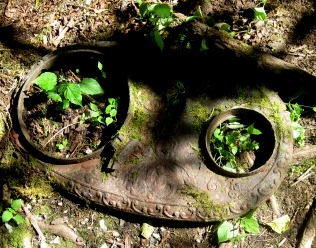Sorry about the long wait in discussing the weekend’s post! (Technical troubles with access here in BlogVille.) In any case, many of you zeroed in on the defunct lime kiln as a possible pH adjuster. It would have been really interesting during those years to see how materials were processed – for instance, was there a lot of lime dust that settled over the area? Where did the limestone come from – was it carted in by train or was it local? Were chlorosis problems visible then?
In any case, my educated guess is that a lot of limestone chunks brought to the area for processing were left scattered around the site and were eventually buried over time. Plants recolonized the area, but where these chunks of limestone are sited we have pockets of chlorosis. The only way to tell for sure would be to test the soil pH, and I did not have pH strips in my backpack.
